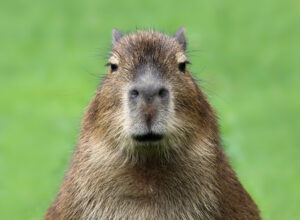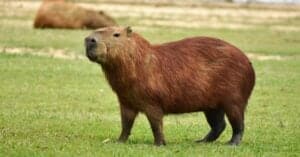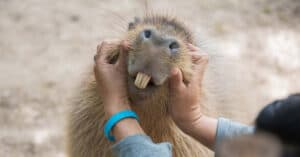Capybaras are one of the most interesting animals in the world. They’re giant rodents that live in South America and weigh up to 150 pounds! Yet, despite their large size, these unique semi-aquatic mammals are docile, gentle herbivores and spend much of their time in the water. Do you know what eats capybaras? Surprisingly, there are quite a few predators that enjoy a good capybara meal. In this article, we’ll explore the various predators that prey on capybaras and learn about their diets. Stay tuned for some interesting facts about these intriguing creatures!
How Do Capybaras Protect Themselves?

Young capybaras may not make it to adulthood due to predation.
©Horus2017/Shutterstock.com
Capybaras are native to South America where they live in ponds, lakes, and rivers with thick forests and vegetation. This, unfortunately, also makes them prey to many of the carnivorous animals that share this same habitat. While they can live for eight to ten years, most capybaras only live around four years in the wild due to this predation, and many baby capybaras never make it to adulthood.
Capybaras live in groups of 10-30, and when one senses danger, it will alert the rest with warning barks. The group will usually try to escape into the water and hide there until the threat is passed. However, capybaras have predators in the water as well as on land. Let’s take a closer look at what eats capybara.
Capybara Predators
1. Caimans
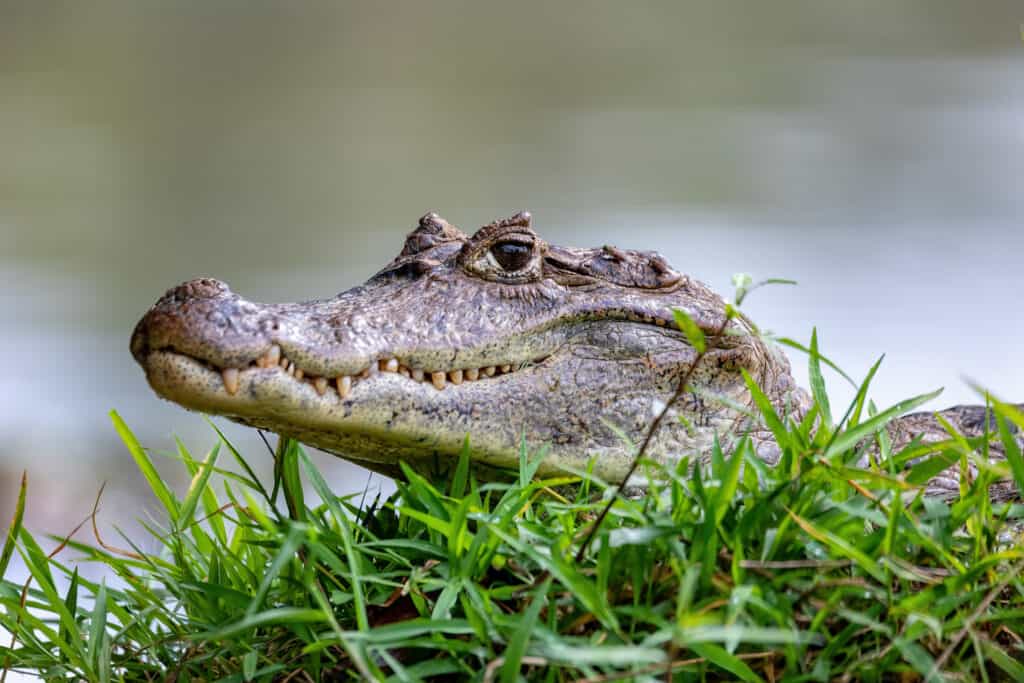
Caimans use their razor sharp teeth to eat an adult capybara.
©Artush/Shutterstock.com
One of the most common predators of the capybara is the caiman. Caimans are large reptiles that are closely related to alligators and crocodiles. They are found in South America and typically inhabit freshwater environments such as rivers, lakes, and swamps, just like capybaras. Caimans vary in size, but they can grow to be quite large — some species like the black caiman can even reach lengths of 20 feet! Such an animal — with excellent stalking skills and razor-sharp teeth — is strong enough to catch even an adult capybara.
Caimans typically hunt at night when their prey is less active. When they spot a potential meal, they will quickly approach and grab it with their powerful jaws before dragging it into the water to drown it. Caimans will eat just about anything they can catch but their preferred diet consists of fish, reptiles, birds, and small mammals like rodents and rabbits. So, it’s no surprise that they will also sometimes prey on capybaras.
2. Green Anaconda
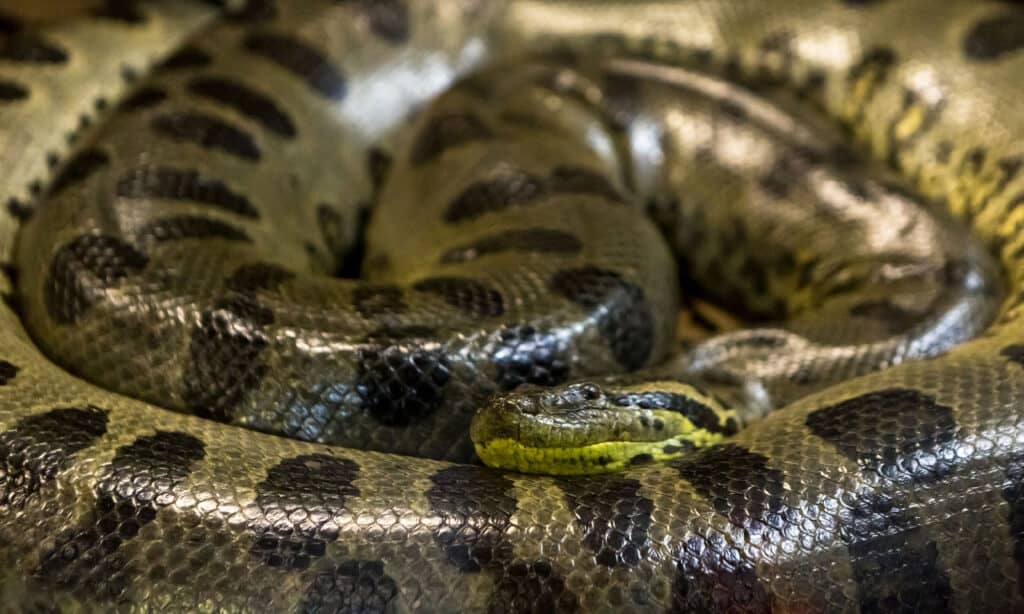
The anaconda is common predator of the capybara.
©iStock.com/MaRabelo
Another common predator of the capybara is the green anaconda. The anaconda is a large snake that is native to South America and is typically found in tropical rainforests near bodies of water such as rivers and swamps. Anacondas can grow to be quite long — some massive snakes have grown to be 30 feet long!
Like caimans, anacondas typically hunt at night when their prey is less active, and they commonly hunt in water. When they spot a potential meal, they will quickly approach and grab it with their powerful jaws before constricting their coils around it to suffocate it. They then swallow their prey whole, which can take weeks to digest. Anacondas eat just about anything they can catch but their preferred diet consists of fish, mammals, and reptiles. Large anacondas are also quite fond of peccaries, deer, and you guessed it, capybaras.
3. Puma

In the absence of deer, pumas would eat capybaras.
©iStock.com/SandmanXX
Pumas (also called South American cougars or mountain lions) are large cats that live in North and South America. They have short fur that is brownish-red in color and they typically weigh between 100-200 pounds. These big cats have muscular legs, they can run very fast, and they have excellent night vision for stalking prey. Pumas are also excellent climbers and can leap up to 15 feet high!
Pumas consume both plants and animals, but their preferred diet consists mostly of deer, rabbits, rodents, birds, and fish. So yet again, it’s no surprise that pumas will also sometimes eat capybaras — especially if deer are scarce in their area.
When they spot a potential meal, they will stalk it until they are close enough to attack. Pumas will then use their powerful hind legs to jump onto their prey and deliver a fatal bite to the neck or throat region. They do not eat the entire animal in one sitting, however. Instead, they use their powerful jaws to drag their prey back to a safe spot and save much of it for later.
4. Jaguar
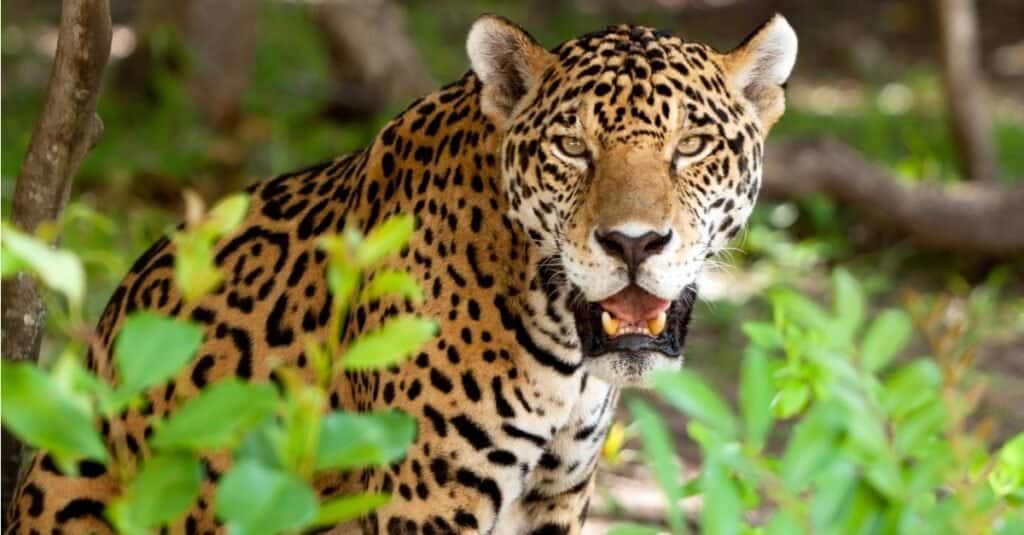
The jaguar is one of the strongest wild cats in terms of its jaws.
©iStock.com/Patryk_Kosmider
Jaguars are one of the most feared predators in the animal kingdom. They have been both worshipped and feared by humans for centuries due to their large size and incredible hunting prowess. These beautiful big cats have powerful jaws and sharp claws that can make quick work of their prey. One of their favorite meals is the capybara.
Capybaras often graze in the early mornings or at night when the temperatures are cooler. During the day they spend much of their time in the water. This makes them easy targets for jaguars, who have excellent night vision and can hunt under the cover of darkness. Jaguars also have largely spotted fur that provides excellent camouflage, so they can hunt during the day as well, and will often stalk their prey before attacking. Once they have caught a capybara, they will usually drag it onto land where they can eat it in peace.
5. Ocelot

Ocelots are excellent swimmers, climbers, and runners, making them almost perfect predators.
©Saad315/Shutterstock.com
Although they are much smaller than many big cats, ocelots are still one of the apex predators in their environment, next to the likes of the jaguar. One of their favorite hunting grounds is around shallow rivers and lakes, where they prey on animals like capybaras. They are stealthy predators that hunt by stalking their prey through the dense jungle undergrowth. When they are close enough, they will pounce, using their powerful claws and teeth to kill their victim.
The large size of an adult capybara makes it a substantial meal for an ocelot. Ocelots will often stalk a capybara for several hours before making their move, patiently waiting for the right opportunity. Once they attack, they will go for the throat, trying to kill their prey as quickly as possible. The ocelot will then drag it into the nearest tree and eat it at its leisure.
6. Harpy Eagle
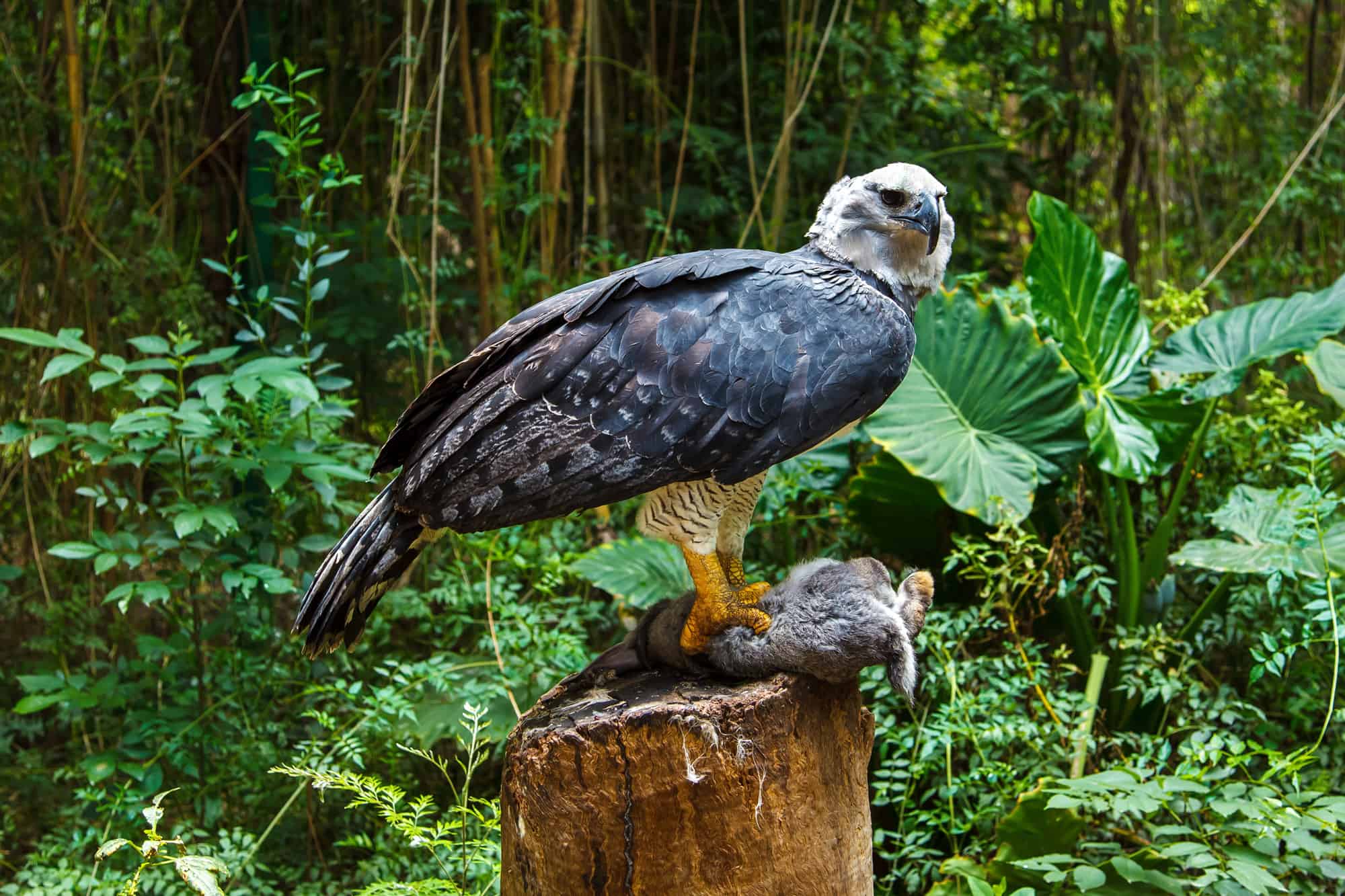
Harpy eagles eat young capybaras.
©ChepeNicoli/Shutterstock.com
One of the largest and most powerful birds of prey in the world is the harpy eagle. These killer birds are known for their impressive size, with a wingspan that can reach up to six feet, and their strength, which allows them to lift prey that weighs up to four times their own body weight. They are formidable predators, preying on animals as large as sloths and monkeys. In the wilds of South America, harpy eagles also eat young capybaras.
When hunting for capybaras, harpy eagles will perch in a tree overlooking a river or pond, waiting for their prey to come close enough to strike. When they see an opportunity, they will dive down at incredible speeds, snatching the capybara with their sharp talons and often killing it instantly with a powerful grip. The eagle will carry it back to its nest, where it will feed it to its young.
7. Crab-Eating Fox
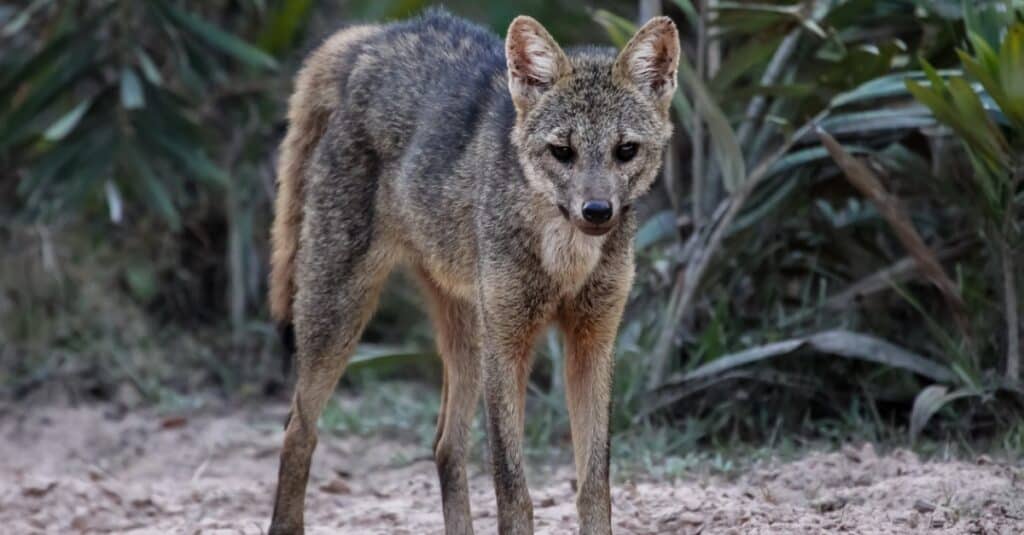
Crab-eating foxes can eat young capybara when their prey gets scarce.
©iStock.com/Uwe-Bergwitz
A crab-eating fox wouldn’t want to mess with a full-size capybara, but they do often hunt the smaller, young ones. Crab-eating foxes are found throughout much of South America, including Brazil, Uruguay, and Argentina. They get their name from their diet, which includes crabs, crayfish, other small invertebrates, and plants. During the wet season, they primarily eat crabs, which are their favorite food.
However, during the dry season when such prey is scarcer, they turn to other sources of food, and occasionally they eat young capybaras. Crab-eating foxes typically hunt alone or in pairs, using their sharp claws and teeth to kill their prey. Once they have killed a capybara, they will drag it to a safe location where they can eat in peace.
8. Humans
Although there are many carnivorous predators in the wild that hunt capybaras, the greatest predator of all is a human. Capybaras are typically very docile animals that live in groups, and some say that their meat is tender and tastes like pork. Because of this, capybaras have been hunted by humans for centuries in South America.
In some cultures, capybara meat is considered a delicacy, and it is often served at special occasions like weddings and festivals, especially in Venezuela. In addition to being a source of food, capybaras also provide pelts and hide that can be used to make clothing and other items.
Although their overall population is stable, there are some areas of South America where capybaras have disappeared due to overhunting. Some of the people, however, also farm capybaras and raise them for their meat, which takes some of the stress off the wild populations of these animals.
Up Next:
- 10 Incredible Capybara Facts
- What Do Capybaras Eat? Their Diet Explained
- Capybara Location: Where Do Capybaras Live?
- Do Capybaras Make Good Pets? Sweet Rodents with Special Needs
The photo featured at the top of this post is © Artush/Shutterstock.com
Sources
- Rainforest Alliance, Available here: https://www.rainforest-alliance.org/species/capybara/
Thank you for reading! Have some feedback for us? Contact the AZ Animals editorial team.



